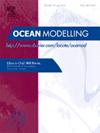混合海高频波浪动力学:涌浪对风浪特性的影响
IF 2.9
3区 地球科学
Q2 METEOROLOGY & ATMOSPHERIC SCIENCES
引用次数: 0
摘要
波浪对风应力和短波特性的影响已得到海洋界的广泛认可。然而,尽管世界上大多数海域每天都有涌浪存在,但在研究有限的风浪时,涌浪通常被忽视。在风浪发展的早期阶段,海洋表面波在调节海气界面之间的热量、动量和气体传输方面起着至关重要的作用。在墨西哥湾进行的一项测量活动中,使用桅杆浮标获得了水波和湍流雷诺应力的定向谱的高时间分辨率连续测量。与冷锋相关的事件被选中。利用Hanson和Phillips(2001)提出的方法将涌浪从当地的风浪中分离出来。据观察,涌浪抑制了年轻的风-海能量。特别是在与风相反的涌浪条件下。在平衡区,有涌浪时的风-海能量比无涌浪时要低得多。此外,涌浪还改变了与多巴常数相关的风海能级,使其达到亚饱和能级。膨胀陡度和膨胀指数是调制短波能量的参数。短波由于耗散的物理机制,由于波峰的不稳定性而损失能量,因此破裂。其次,膨胀降低了与短波相关的表面粗糙度,减少了从大气中提取动量的能力,从而减少了从风中提取的能量。结果表明,浪涌对风-海的影响取决于浪涌相对于风的方向、浪涌能量比和浪涌陡度等因素。本文章由计算机程序翻译,如有差异,请以英文原文为准。
High-frequency wave dynamics in mixed seas: The influence of swells on wind waves characteristics
The effect of the swell in modifying wind stress and short wave properties is well-recognized in the oceanographic community. Nevertheless, the swell is generally neglected in studies of fetch-limited wind waves despite its everyday presence in most of the world’s seas. During the early stages of wind wave development, ocean surface waves play a crucial role in modulating heat, momentum, and gas transfer between air–sea interfaces. In a measurement campaign conducted in the Gulf of Mexico, continuous measurements with a very high temporal resolution of the directional spectrum of water waves and turbulent Reynolds stresses were obtained using a spar buoy. Events associated with cold fronts were selected. The swell was separated from the local wind-generated waves using the method proposed by Hanson and Phillips (2001). It was observed that the swell dampens young wind-sea energy. In particular, under conditions of swell opposite to the wind. In the equilibrium region, the wind-sea energy is much lower when the swell is present than when it is not. In addition, the swell modifies the energy level of the wind-sea related to the Toba constant, bringing it to a sub-saturated energy level. Swell steepness and swell index are parameters that contribute to modulating short-wave energy. Short waves lose energy by the physical mechanism of dissipation, by the instability of their crest, and therefore break. In a secondary role, the swell reduces the energy extracted from the wind by reducing the surface roughness associated with short waves and less capacity to extract momentum from the atmosphere. It is concluded that the impact of the swell on the wind-sea depends on several factors, such as the swell direction relative to the wind, the swell energy ratio, and the swell steepness.
求助全文
通过发布文献求助,成功后即可免费获取论文全文。
去求助
来源期刊

Ocean Modelling
地学-海洋学
CiteScore
5.50
自引率
9.40%
发文量
86
审稿时长
19.6 weeks
期刊介绍:
The main objective of Ocean Modelling is to provide rapid communication between those interested in ocean modelling, whether through direct observation, or through analytical, numerical or laboratory models, and including interactions between physical and biogeochemical or biological phenomena. Because of the intimate links between ocean and atmosphere, involvement of scientists interested in influences of either medium on the other is welcome. The journal has a wide scope and includes ocean-atmosphere interaction in various forms as well as pure ocean results. In addition to primary peer-reviewed papers, the journal provides review papers, preliminary communications, and discussions.
 求助内容:
求助内容: 应助结果提醒方式:
应助结果提醒方式:


